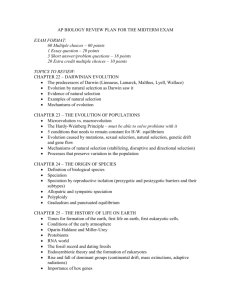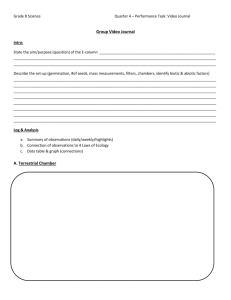here - FIU - Ecology Lab
advertisement
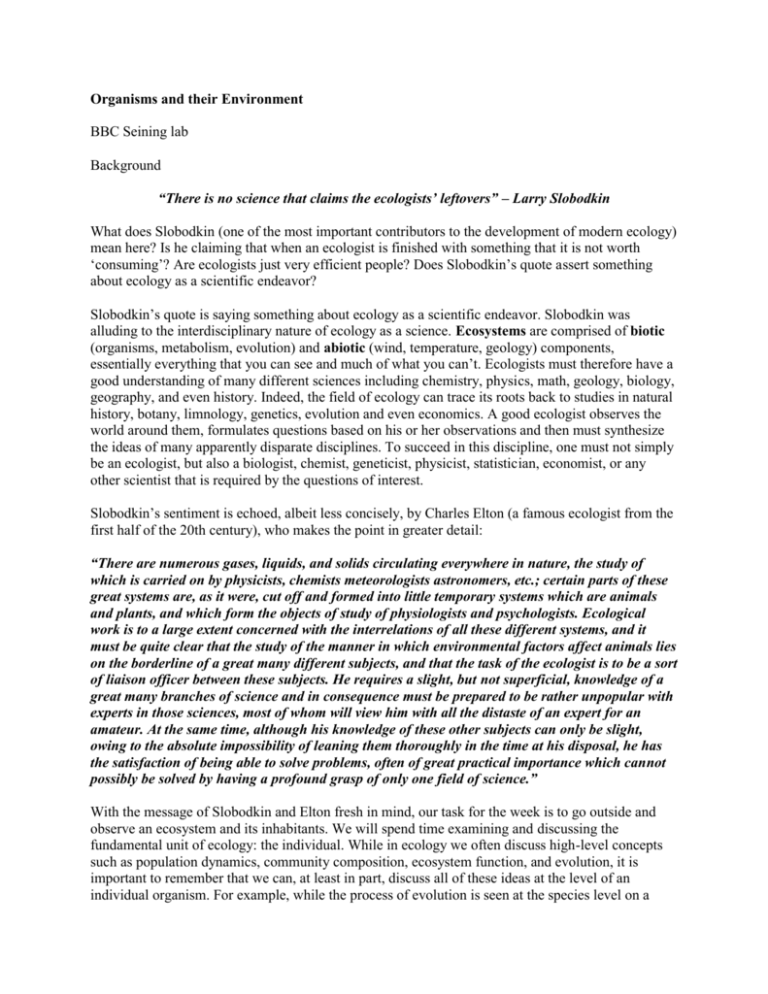
Organisms and their Environment BBC Seining lab Background “There is no science that claims the ecologists’ leftovers” – Larry Slobodkin What does Slobodkin (one of the most important contributors to the development of modern ecology) mean here? Is he claiming that when an ecologist is finished with something that it is not worth ‘consuming’? Are ecologists just very efficient people? Does Slobodkin’s quote assert something about ecology as a scientific endeavor? Slobodkin’s quote is saying something about ecology as a scientific endeavor. Slobodkin was alluding to the interdisciplinary nature of ecology as a science. Ecosystems are comprised of biotic (organisms, metabolism, evolution) and abiotic (wind, temperature, geology) components, essentially everything that you can see and much of what you can’t. Ecologists must therefore have a good understanding of many different sciences including chemistry, physics, math, geology, biology, geography, and even history. Indeed, the field of ecology can trace its roots back to studies in natural history, botany, limnology, genetics, evolution and even economics. A good ecologist observes the world around them, formulates questions based on his or her observations and then must synthesize the ideas of many apparently disparate disciplines. To succeed in this discipline, one must not simply be an ecologist, but also a biologist, chemist, geneticist, physicist, statistician, economist, or any other scientist that is required by the questions of interest. Slobodkin’s sentiment is echoed, albeit less concisely, by Charles Elton (a famous ecologist from the first half of the 20th century), who makes the point in greater detail: “There are numerous gases, liquids, and solids circulating everywhere in nature, the study of which is carried on by physicists, chemists meteorologists astronomers, etc.; certain parts of these great systems are, as it were, cut off and formed into little temporary systems which are animals and plants, and which form the objects of study of physiologists and psychologists. Ecological work is to a large extent concerned with the interrelations of all these different systems, and it must be quite clear that the study of the manner in which environmental factors affect animals lies on the borderline of a great many different subjects, and that the task of the ecologist is to be a sort of liaison officer between these subjects. He requires a slight, but not superficial, knowledge of a great many branches of science and in consequence must be prepared to be rather unpopular with experts in those sciences, most of whom will view him with all the distaste of an expert for an amateur. At the same time, although his knowledge of these other subjects can only be slight, owing to the absolute impossibility of leaning them thoroughly in the time at his disposal, he has the satisfaction of being able to solve problems, often of great practical importance which cannot possibly be solved by having a profound grasp of only one field of science.” With the message of Slobodkin and Elton fresh in mind, our task for the week is to go outside and observe an ecosystem and its inhabitants. We will spend time examining and discussing the fundamental unit of ecology: the individual. While in ecology we often discuss high-level concepts such as population dynamics, community composition, ecosystem function, and evolution, it is important to remember that we can, at least in part, discuss all of these ideas at the level of an individual organism. For example, while the process of evolution is seen at the species level on a time scale of hundreds to millions of years, evolution works at the level of an individual. Evolution occurs because an individual’s genetic make-up increases or decreases the likelihood that the individual will successfully navigate biotic interactions and the abiotic environment to eventually reproduce. Individuals that are more likely to survive and reproduce are said to be better adapted to their environment. Adaptations are therefore defined as a genetically determined phenotypic trait (e.g., morphology, behavior or physiology) that improves an organism’s ability to survive and reproduce under prevailing environmental conditions. In this week’s lab we will be focusing on how evolution has acted on the species in Biscayne Bay. We will examine the morphological and behavioral adaptations of fish living in Biscayne Bay and discuss how these adaptations are beneficial to specific environmental pressures. What are the pieces, and how do they function, individually and together? Ecology is complex and gaining first-hand knowledge of these components will aid your ability to develop and synthesize information from complex systems; skills that will help you no matter what your career path. Today we will be discussing: 1. The abiotic conditions (Light levels, habitat structure, etc) 2. The biotic components (Predators, competitors, food availability, etc) 3. How the biotic and abiotic components form the template upon which natural selection can act, thereby resulting in specific adaptations of plants and animals Lab Activity We will be heading outside to sample some of the marine organisms that live on the shoreline of the BBC campus. We will be looking at the different ways that these organisms are adapted to their environment and specialized to their particular lifestyle (predator, grazer, etc.). Project Description: We will sample two different locations: the beach area just northeast of MSB (Windy Beach) and the beach southeast of MSB along the bike path (Sheltered Beach) (see map below). These two sites represent very different conditions for aquatic organisms. Windy Beach is usually facing right into the wind, increasing the possibly for stirring up the sediment. Furthermore, there are few structures between this beach and Haulover Pass, meaning more direct water flow from the ocean. The sides of this beach, particularly the east side, are constrained by sediment-stabilizing rocks. The Sheltered Beach, as its name suggests, tends to be out of the direct path of water flow from Haulover, and also is surrounded by many trees, protecting it from the wind. There is little in the way of shoreline structure besides mangrove prop roots. At each beach we will be dragging a seine net along the bottom and through the water column. The seine net has a lead line, which will help to hold down the net and prevent fishes from escaping out the bottom. Your TA will show you how a team of people working together can efficiently capture a lot of fishes with little effort. At the end of dragging the seine, all fishes will be brought up on shore and placed into buckets. From there, we can ID species, get total count by species, and get the lengths of the individuals captured. This is known as catch-per-unit-effort (CPUE) sampling. CPUE is a commonly used metric in fisheries biology, where the exact size of the area sampled may vary from sample to sample, but the time and energy (unit effort) put into each sample are the same. Your TA will determine the number of samples necessary for each beach, but the more the better. More samples means you get a better picture of what types of fish live off the beach and how abundant they are. After each sampling week, your CPUE will be compiled with those of the other classes so that we can increase our sample size and the accuracy of our data. *** Please be careful when handling the fish. Many species are sensitive and the less we handle them, the better off they’ll be. Also, some species, such as puffers and rays, have spines that can be dangerous to you. *** What to Expect We will be going outside for an hour or two. Below are some things to consider. In addition to these you should be prepared to take notes while we are outside. Water: I will be getting in the water, along with one or two students, to catch fish and find invertebrates. If anyone thinks that they might want to help with the seine netting be prepared to get in water up to your chest. Insects: If mosquitoes bother you, bring repellant. Sun: Wear clothes that protect you from the sun or bring sun block. Heat: Bring drinking water if you think you will need it. Fish Adaptations: Helpful website www.dep.state.fl.us/secretary/ed/life/ichetucknee/files/5_fish_adaptations_seine.pdf to see some examples of the different adaptations fishes have to survive.
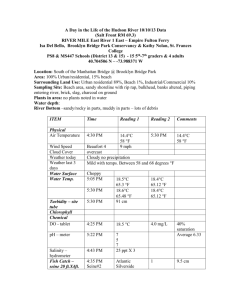

![[CLICK HERE AND TYPE TITLE]](http://s3.studylib.net/store/data/006863514_1-b5a6a5a7ab3f658a62cd69b774b6606c-300x300.png)


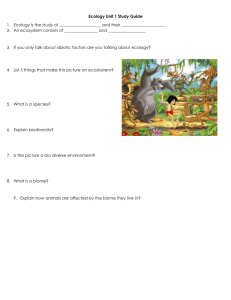
![PERSONAL COMPUTERS CMPE 3 [Class # 20524]](http://s2.studylib.net/store/data/005319327_1-bc28b45eaf5c481cf19c91f412881c12-300x300.png)
